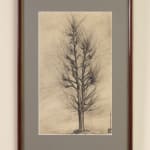

24
Tree
Framed: 24 1/2'' h x 16 1/4'' w
The drawing “One Tree” is pregnant with Pathos without devolving into sentimentality. Through an intensity of emotion, Chusei Inagaki’s perspective on this tree becomes fiercely personal; no one else could...
The drawing “One Tree” is pregnant with Pathos without devolving into sentimentality. Through an intensity of emotion, Chusei Inagaki’s perspective on this tree becomes fiercely personal; no one else could have seen and interpreted it in quite the same way. It is not difficult to see the artist himself reflected and embodied as this tree, a testament to the strength of his artistic vision.
One of the successes of the work lies in Inagaki’s undigested new knowledge of perspective. In the era, perspectival depth and space was a new technique in Japan, borrowed from a novel engagement with Europe and its artistic traditions. The tree is positioned somewhere in between flatness and depth, within a space of tension that expresses the artist’s uneasiness with its form.
Through a balance of seeing and feeling the tree in front of him, Inagaki summoned a sense of foreboding and imbalance that captured the tumult of his own interiority as well as the changing cultural landscape in Japan.
About the Artist
Chusei Inagaki was born in 1897 and died in 1922, living only 25 years. In his short life, he observed with his own eyes, interpreted with his own mind, studied searching his own expression, painted and drew in his own way. He was born too early and died too young. Inagaki left behind so many masterpieces, many of which now hang in museums, but his talent was not appreciated during his time. His works received savage criticism, and were labeled as iconoclasts by old school academics and critics. He did not live long enough to defend himself, but now museums are competing to acquire his works. His paintings and drawings, like this one, possess realism imbued with a psychological disquietude, a rare expression for Japan in that era.
One of the successes of the work lies in Inagaki’s undigested new knowledge of perspective. In the era, perspectival depth and space was a new technique in Japan, borrowed from a novel engagement with Europe and its artistic traditions. The tree is positioned somewhere in between flatness and depth, within a space of tension that expresses the artist’s uneasiness with its form.
Through a balance of seeing and feeling the tree in front of him, Inagaki summoned a sense of foreboding and imbalance that captured the tumult of his own interiority as well as the changing cultural landscape in Japan.
About the Artist
Chusei Inagaki was born in 1897 and died in 1922, living only 25 years. In his short life, he observed with his own eyes, interpreted with his own mind, studied searching his own expression, painted and drew in his own way. He was born too early and died too young. Inagaki left behind so many masterpieces, many of which now hang in museums, but his talent was not appreciated during his time. His works received savage criticism, and were labeled as iconoclasts by old school academics and critics. He did not live long enough to defend himself, but now museums are competing to acquire his works. His paintings and drawings, like this one, possess realism imbued with a psychological disquietude, a rare expression for Japan in that era.
Exhibitions
The work, “One Tree” was exhibited at the Kyoto’s National Museum of Modern Art in the exhibition “The Inagaki Brothers: Chusei & Toshijiro.”
Signup for our Newsletter
You will receive two emails a month from us. One introduces artworks and design works from Kyoto's hidden sources and the other is stories from Misako, sharing insights into Japanese culture.
* denotes required fields
为了回应您的查询,我们将根据我们的隐私政策处理您提供的个人数据。

